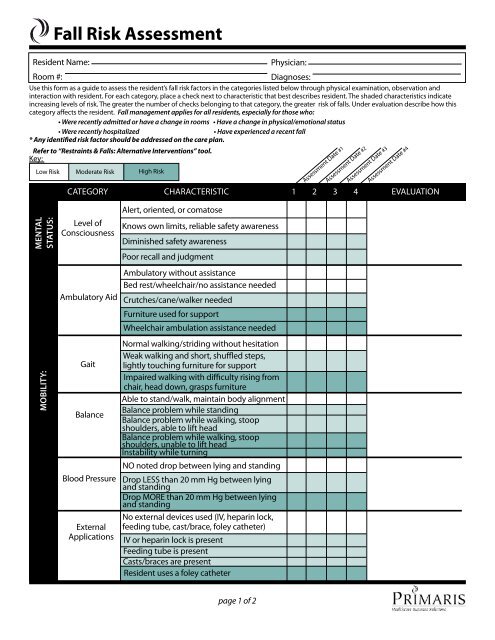4 Simple Techniques For Dementia Fall Risk
The Best Guide To Dementia Fall Risk
Table of ContentsAn Unbiased View of Dementia Fall RiskIndicators on Dementia Fall Risk You Need To KnowThe Buzz on Dementia Fall RiskThe Only Guide for Dementia Fall RiskEverything about Dementia Fall Risk
Based on indications and symptoms, such as proof of head injury or a new focal neurologic deficit, computed tomography or MRI of the mind may be suggested. An evaluation for causes of syncope need to be conducted just if there is strong uncertainty, as when it comes to recurrent, inexplicable falls
Healthcare suppliers utilize a loss danger assessment to identify your threat aspects for dropping and make handy suggestions. An autumn threat analysis is vital since recognizing which variables raise your chances of falling aids you: Reduce your risk of falling or harming yourself.
All grownups 65 years and older should have a first loss threat screening. Have dropped in the past year. Worry regarding falling.
The Single Strategy To Use For Dementia Fall Risk

Explore this comprehensive nursing treatment strategy and management guide to effectively stop danger for falls among people. Get necessary understanding concerning the nursing evaluation, taking care of diagnosis, and goals particularly tailored to individuals that go to risk for drops. A is specified as an occasion that leads to an individual coming to relax unintentionally on the ground or flooring or various other lower degree (THAT, 2021).
Falling is the second leading reason of fatality from unintentional injuries worldwide. It is estimated that loss death rates in the U.S
An Unbiased View of Dementia Fall Risk
If this price continues, the CDC anticipates seven loss fatalities every hour by 2030.
Each year, over 800,000 clients are hospitalized because of falls. Nurses play a significant role in protecting against drops for their individuals through education and learning, assessing autumn risk, developing more secure settings, and providing interventions in stopping injuries from drops.
Person will certainly show discerning prevention measures. Patient and caregivers will carry out methods to raise security and protect against falls in the home. Falls result from several aspects, and an all natural strategy to the specific and setting is essential. Mean a person is considered at high risk for falls after the testing.
Little Known Facts About Dementia Fall Risk.
A requires utilizing a verified tool that scientists have actually taken a look at to be valuable in naming the reasons of drops in a person. The level of autumn threat can be established utilizing the evaluation of innate and extrinsic elements.
Individuals are much more likely to drop once more if they have sustained one or more falls in the past six Read More Here months. The older population is at increased threat of fall-related readmissions based on a study identifying the elements predictive of repeat falls associated outcomes (Prabhakaran et al., 2020).
The capacity of people to safeguard themselves from drops is affected by such factors as age and advancement. Older individuals with weak muscle mass are much more likely to fall than those who keep muscle stamina, flexibility, and endurance.
The Ultimate Guide To Dementia Fall Risk
Much less contrast sensitivity was rather connected with both boosted rates of drops and other injuries, while decreased visual skill was just connected with enhanced autumn rate (Wood et al., 2011). Sensory assumption of environmental stimulations is vital to safety. Vision and hearing impairment limitation the person's capability to perceive dangers in the hop over to here environments.
Older adults who have bad equilibrium or difficulty walking are more probable to fall. These issues may be connected with absence of our website workout or a neurological cause, joint inflammation, or various other clinical conditions and therapies. A vital risk element highlighted in a study is that adults with rheumatoid arthritis go to high risk of falls, consisting of puffy and tender lower extremity joints, exhaustion, and use of psychotropic drugs (Stanmore et al., 2013).